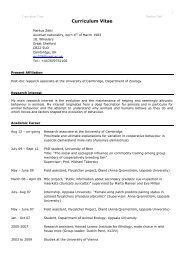Commercializing bycatch can push a fishery beyond economic ...
Commercializing bycatch can push a fishery beyond economic ...
Commercializing bycatch can push a fishery beyond economic ...
Create successful ePaper yourself
Turn your PDF publications into a flip-book with our unique Google optimized e-Paper software.
Bycatch landing drives overfishing in India A.S. Lobo et al.<br />
Avreage No. of live chickens (millions)<br />
600<br />
500<br />
400<br />
300<br />
200<br />
100<br />
0<br />
1978 1988 1998 2007<br />
Figure 4 Growth of the poultry industry in India expressed as the average number of live chickens per year (in millions). (source: http://faostat.fao.org).<br />
extra income earned from <strong>bycatch</strong>. These two locations<br />
presumably performed <strong>economic</strong>ally better than Nagapattinam<br />
because they had fewer trawlers (CMFRI 2007).<br />
In addition, trawling was only introduced to Mudasalodoi<br />
in 1985.<br />
We recognize that relying on interviews with fishers<br />
to reconstruct catch data across time is subject to error<br />
because of imprecise recall. Interview techniques have<br />
however been shown to be effective, and often the only<br />
available way to garner information from data-poor fisheries<br />
(Drew 2005; Saenz-Arroyo et al. 2005; Moreno et al.<br />
2007; Ban et al. 2009), including information on fishing<br />
effort and <strong>bycatch</strong> (Foster & Vincent 2010; Moore et al.<br />
2010). It is also possible to validate interviews by comparing<br />
certain responses with other quantitative sources<br />
(Gilchrist et al. 2005). We were unable to crosscheck our<br />
interview data on <strong>bycatch</strong>, because standard monitoring<br />
programs for marine landings in India focus largely<br />
on target species (Srinath 2006). However, trends derived<br />
from our interviews for target species broadly match<br />
those from three other published datasets for target trawl<br />
catches, one for the entire state of Tamil Nadu (Srinath<br />
2006), and the other two for the Chennai fish landing<br />
site for total target catches (Devaraj & Vivekanandan<br />
1999) and penaeid shrimp catches (Thangaraj Subramaniam<br />
2002). The catches in these three separate studies<br />
peaked around the same period (1995–1998), which conforms<br />
to the trends in our study (Figure 5).<br />
The increase in total catch of target species in Nagapattinam,<br />
during the first two decades of our study<br />
(1978–1998) could be attributed to the introduction of<br />
trawlers equipped with novel and efficient technology<br />
to a region predominantly fished by nonmotorized artisanal<br />
craft (Bavinck 2001). Over the past decade, however,<br />
total catch has declined steeply, reflecting a sustained<br />
fall in CPUE of target species beginning in the<br />
1990s (see also Devaraj & Vivekanandan 1999). These<br />
declines are almost certainly due to increasing fishing<br />
effort, common across India, which is now exhausting<br />
near-shore resources (Bavinck 2005). Across southeast<br />
India as a whole (of which the Coromandel Coast constitutes<br />
nearly a third), the mechanized fleet (trawlers)<br />
expanded eightfold between 1961 and1998 (Vivekanandan<br />
et al. 2005). The effects of increasing trawler capacity<br />
have probably been compounded by large-scale motorization<br />
of artisanal craft in the last decade, particularly<br />
in the wake of the 2004 tsunami (Pomeroy et al. 2006),<br />
a process that has further increased fishing effort in this<br />
region (Salagrama 2006; Salagrama & Koriya 2008).<br />
Even at Pazhaiyar and Mudasalodoi, this increased effort<br />
is associated with falling catches, CPUE, and income.<br />
At Nagapattinam, CPUE and income from target species<br />
have fallen so greatly that, coupled with rising costs, the<br />
<strong>fishery</strong> is no longer profitable based on its target catch<br />
alone. By analyzing rarely reported data on nontarget<br />
groups, we have been able to show that the Nagapattinam<br />
<strong>fishery</strong> has remained <strong>economic</strong>ally viable (albeit<br />
barely) by landing increasing amounts of <strong>bycatch</strong>. This<br />
shift in behavior has been catalyzed by several changes in<br />
the market for <strong>bycatch</strong>.<br />
On the one hand, seafood (including commercial <strong>bycatch</strong>)<br />
has become an increasingly important part of the<br />
diet of the expanding middle class in India (Salagrama<br />
2004). Several species of commercial <strong>bycatch</strong> are now<br />
282 Conservation Letters 3 (2010) 277–285 Copyright and Photocopying: c○2010 Wiley Periodicals, Inc.





